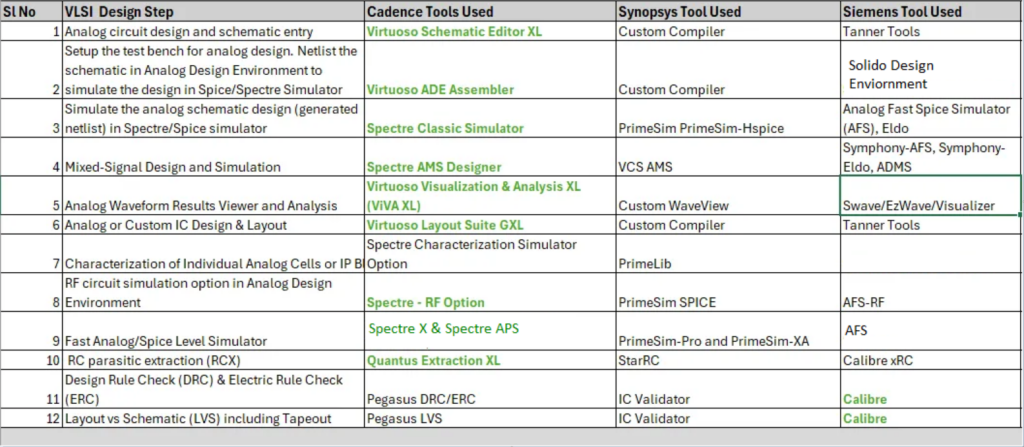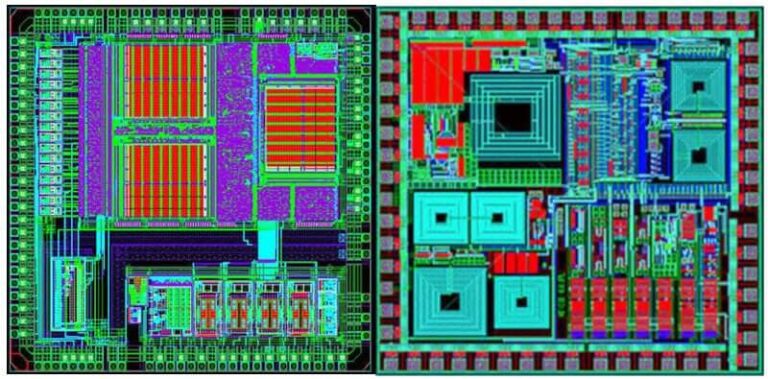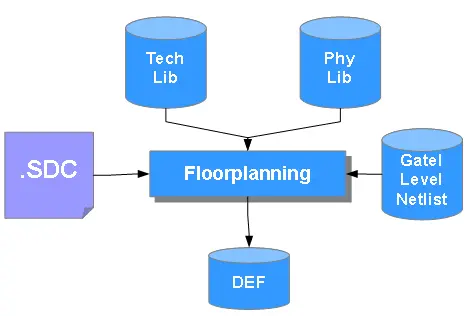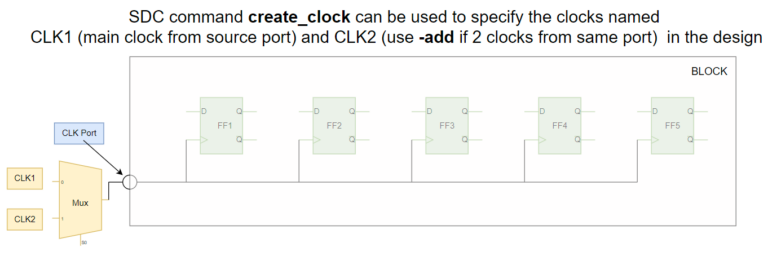Top EDA Tools for Analog & Mixed Signal IC Design
Top EDA Tools for Analog & Mixed Signal IC Design
In the intricate world of integrated circuit (IC) design, selecting the right electronic design automation (EDA) tool is pivotal for success, especially in the realms of analog and mixed-signal designs. These EDA tools, encompassing analog synthesis, simulations with a SPICE simulator, and complex analog modeling, are crucial for engineers tackling the challenges of analog circuit design. Their importance has magnified in today’s technology landscape, where precision, efficiency, and innovation are non-negotiable. With the right EDA tool, designers can significantly reduce the development time and enhance the reliability and performance of their analog and mixed-signal circuits.
This article delves into the essential EDA tools that are critical in the design flow of analog and mixed-signal ICs. Starting with an overview of the design flow itself, it will shed light on the key EDA tools used in analog design, including the popular SPICE simulators and Verilog-AMS for analog synthesis and modeling. Further, it will explore the top tools specifically tailored for mixed-signal design, highlight leading EDA companies’ contributions to this sector, and discuss the preferences among engineers for different tools based on their specific needs and projects. The discussion will also extend to emerging trends in analog/mixed-signal EDA tools, outlining current challenges and providing insights into the future outlook of this critical field.
Importance of EDA Tools in Analog & Mixed Signal IC Design
Electronic Design Automation (EDA) tools have become indispensable in the realm of analog and mixed-signal integrated circuit (IC) design. As the complexity of ICs increases, the role of EDA tools in ensuring efficient, reliable designs becomes more critical. This section delves into the pivotal role of EDA tools in analog and mixed-signal IC design, highlighting their significance in addressing the unique challenges posed by these types of circuits.
Evolution and Growth of EDA Tools
EDA tools for analog, mixed-signal, and RF design have seen rapid growth, with double-digit annual growth rates in recent years. Despite this, the scope of tools for analog and mixed-signal design has not expanded as extensively as those for digital design [10]. The evolution of EDA tools is crucial to meet the demanding verification needs of next-generation chips, especially as analog IC design continues to evolve [7].
Challenges in Analog Design Automation
Digital design automation benefits significantly from the use of abstracted representations of standardized electronic components, facilitating easier synthesis and simulation of designs. However, achieving higher levels of abstraction for analog design techniques has proven more challenging for the EDA industry [10]. This difficulty arises from the artistic element and specialized skills required in analog design, making automation of the design process complex [10].
The Shift Towards Digital Verification Techniques
There is a growing recognition of the benefits of adopting digital verification techniques for the functional verification of analog and mixed-signal designs. This paradigm shift indicates a move towards integrating digital methodologies into analog design processes, potentially leading to more efficient verification and design workflows [10].
Potential for Machine Learning in Analog Design
Machine learning algorithms hold promise for introducing new automation options in analog design methodologies. With analog design finding applications in areas like artificial intelligence, the potential for machine learning to process vast amounts of measurement data and provide valuable design insights is significant [10]. This could lead to improvements in designer productivity and the optimization of analog design processes.
Revenue and Market Share
Despite the importance of analog and mixed-signal design in various digital markets, analog and mixed-signal tools account for a small percentage of the overall EDA software market. In 1999, mixed-signal design tools, mostly simulators, generated revenues of $87.3 million, which was not even 10% of the EDA software market [11]. This underscores the disparity between the demand for and the development of EDA tools tailored for analog and mixed-signal design.
The Future of Analog EDA Tools
The future of analog design tools is expected to see further alignment with digital design tool methodologies. With increasing analog content in modern electronic devices, the need for analog engineers to move away from manual design work is becoming more apparent. Enhancements in analog simulators and the incorporation of new algorithms for matrix solving are steps towards addressing the challenges in analog design and simulation [10].
In conclusion, EDA tools play a crucial role in the design and verification of analog and mixed-signal ICs. Despite the challenges and current limitations in automating analog design processes, advancements in technology and methodologies are paving the way for more efficient and reliable design workflows. The integration of digital verification techniques and the potential application of machine learning in analog design are promising developments that could revolutionize the field of analog and mixed-signal IC design.
Overview of the Analog & Mixed Signal Design Flow
The design flow for integrated circuits (IC) that feature both analog and digital circuitry, known as mixed-signal IC design flow, is a complex yet structured process that ensures the seamless integration of these two domains. Modern ICs often encompass elements from both analog and digital realms, necessitating a variety of system-on-chip (SoC) and system-in-package (SiP) technologies. These technologies incorporate each IC design domain on a single IC or in packages with different semiconductor processes and sub-ICs, which is increasingly common in compact and sophisticated hardware like automotive radar. Such devices perform a wide range of functions, from sensing and processing to mathematical manipulation and communication, all within a single unit [13].
Domain-Specific Design Steps
- Analog/RF Design
-
- Schematic Capture
- Analog Simulation
- Mixed-Signal Analysis
- Physical Layout
- Physical Verification
- Post Layout Simulation
- Digital Design
-
- Design Entry
- Behavioral Simulation
- Synthesis
- Place and Route
- Functional Verification
- Integration
-
- Full Chip Assembly & Physical Verification
- Mixed-Signal Functional Verification
- Tape-Out
These mixed-signal designs typically involve several teams working in tandem, necessitating a unifying EDA tool that ensures each aspect of the design adheres to process constraints. This is particularly crucial as SoC processes often struggle to meet the analog and RF performance criteria due to relatively poor optimization for these domains [13].
Challenges and Solutions in Mixed Signal Design
Mixed signal design intricately weaves digital and analog circuitry within the same board. While analog signals, originating outside the board, must be translated to digital signals, ensuring proper insulation between aggressor and victim signals is paramount to prevent noise. Analog signals are generally more susceptible to interference from digital signals due to the latter’s fast-switching nature. This necessitates a central philosophy in mixed signal design: isolation [14].
Layout Planning and Shielding
Layout planning is critical and takes on added importance in mixed signal design, where the interaction between signals is a significant concern. Designers begin by dividing the board into digital and analog regions, with high-impedance analog inputs and high-speed digital outputs positioned towards opposite edges of the board. This facilitates an easy-to-follow design flow, with aggressive or sensitive signals placed as far away from the center as possible to minimize potential interaction [14].
Shielding is employed to insulate the design from external interference, using guard rings or ground layers between aggressor/victim signal pairs. This approach, akin to a healthy ground/power design, aims to protect slow analog signals from the rapid switching of digital lines. The return plane also plays a crucial role, with designers needing to minimize the return path while providing a consistent reference to avoid EMI leakage and other issues [14].
Analog and Mixed-Signal Circuit Design Considerations
Designing components like amplifiers, filters, and data converters in analog and mixed-signal (AMS) circuits is often complex and time-consuming. This process typically requires manual design expertise and iterations. However, advancements such as Agile Analog’s scalable platform are automating parts of the design process, making analog design more accessible and accelerating the development of analog ICs for various applications [16].
Analog IC design involves a more personalized focus compared to digital IC design, starting with specifications and features leading to decisions on device size, type, and process features. This includes the selection of transistor types, high-level floorplanning, and inclusion of specific technologies. The design process encompasses architecture definition, circuit design, simulation and verification, layout, post-layout simulation and verification, and finally, tape-out. Each step is critical, with simulation ensuring that the circuits meet specifications and the layout impacting circuit performance significantly [17][18].
This overview highlights the intricate balance and coordination required in the analog and mixed-signal design flow, underscoring the importance of domain-specific design steps, meticulous layout planning, and the integration of advanced tools and methodologies to address the challenges inherent in these complex designs.
Top EDA Tools Used in Analog Design
In the domain of analog design, the selection and application of the appropriate Electronic Design Automation (EDA) tools are crucial for achieving accurate and efficient simulation results. This section delves into some of the key EDA tools used in analog design, focusing on SPICE simulators, HSpice, and PSpice, which are instrumental in the design and verification processes of analog circuits.
Free SPICE Simulators
SPICE (Simulation Program with Integrated Circuit Emphasis) simulators are foundational tools in analog circuit design, providing engineers with the capabilities to simulate and analyze electronic circuits before physical prototyping. Among the plethora of options available, certain simulators have gained prominence due to their specific features and widespread adoption.
- LTspice: Developed by Analog Devices, LTspice is a free-to-use tool that runs on Windows, macOS, and Wine. It supports netlist simulation for analog circuits and is notable for its frequent updates and large user base [24].
- Micro-Cap: Although it reached its end-of-life in 2021, Micro-Cap was a free tool for Windows that supported both analog and digital netlist simulation. It was compatible with various formats including HSPICE, PSPICE, and SPICE3 [24].
- Ngspice and Gnucap: These tools offer cross-platform support and are tailored for both analog and mixed-signal circuit simulation. Ngspice is available on multiple operating systems including Linux and Windows, while Gnucap, written in C++11, can run on any system [24].
HSpice
HSpice stands out in the realm of SPICE simulators due to its advanced simulation capabilities and performance. It is particularly favored for its fast simulation of high-density circuits, which can encompass over 100,000 transistors. The tool is renowned for its algorithm that ensures better convergence and the provision of more accurate device models, which significantly reduce issues related to convergence. Additionally, HSpice allows for the selection and customization of integration algorithms, employing a unique method to achieve convergence by adjusting the conductance connected to each device in the circuit. This feature, coupled with its superior device models, makes HSpice a preferred choice for intricate analog design tasks [22].
PSpice
PSpice, on the other hand, is recognized for its user-friendly and aesthetically pleasing interface, making it accessible to a broad range of users. Despite its advantages in usability, PSpice may encounter limitations when simulating circuits with a large number of transistors, where its performance may not match that of more advanced simulators like HSpice. Furthermore, users have reported challenges with PSpice in terms of support for certain MOS models, which are crucial for IC design. However, HSpice addresses these concerns by allowing the use of text datasheets or libraries for simulation, showcasing its adaptability and comprehensive support for various models [22].
The exploration of these key EDA tools underscores the diverse requirements and preferences in the field of analog design. Engineers and designers must carefully consider the specific features, performance, and support offered by each tool to select the most suitable option for their design projects.
Top EDA Tools for Mixed Signal Design
In the dynamic field of mixed-signal design, engineers often face the challenge of integrating analog and digital components seamlessly. The complexity of these designs necessitates the use of advanced Electronic Design Automation (EDA) tools that can handle both analog and digital signals efficiently. This section explores the top EDA tools for mixed-signal design, focusing on mixed-signal simulators and top-down design approaches that facilitate the creation of high-performance integrated circuits (ICs).
Mixed-Signal Simulators
- AMS Designer: A pivotal tool in mixed-signal design is AMS Designer, which combines technology from Spectre, Spectre X (or APS) with the Xcelium solver. Delivered in the INCISIV stream, AMS Designer is a single-executable simulator housing two “solvers” – one for analog (Spectre) and another for digital (Xrun) simulations. This tool allows for the simulation of pure digital portions using the digital solver in languages such as Verilog/VHDL/SystemVerilog, while the analog parts are handled by the analog solver. The integration of these solvers ensures synchronized simulations, providing a comprehensive solution for mixed-signal designs [29].
- Symphony Mixed-Signal Platform: Introduced by Siemens, the Symphony Mixed-Signal Platform stands out for its digital-simulator agnostic nature. It leverages Siemens’ Analog FastSPICE (AFS) simulator for the analog segments of mixed-signal designs. The platform addresses the intricacies of mixed-signal simulation by handling the “wibbly-wobbly” parts of the process, making it a robust choice for designers [30].
- Symphony Pro: Building on the foundation of the Symphony platform, Siemens unveiled Symphony Pro, often referred to as “Symphony on Steroids”. This next-generation solution integrates the Siemens EDA Questa logic simulator with AFS, extending the mixed-signal verification capabilities to support new and advanced Accellera standardized verification methodologies. It features a comprehensive visual debug cockpit, making it a powerful tool for mixed-signal design verification [30].
Top-Down Design Approaches
The top-down design approach is a methodical process that progresses from architecture to transistor-level design. This approach encourages the partitioning of the design into smaller, well-defined blocks, allowing multiple designers to collaborate productively. It not only reduces the total time required for the design but also enhances communication among designers, minimizing flaws due to miscommunication. The formal nature of this communication supports the effective collaboration of designers located at different sites [31].
Advantages of Top-Down Design
- Modularity: Promotes breaking down complex systems into smaller, manageable modules. Each module can be developed and tested independently, simplifying the development process [32].
- Abstraction: Allows designers to focus on high-level aspects without delving into implementation details, aiding in understanding the system as a whole [32].
- Ease of Maintenance: Facilitates easier updates or changes to the system by modifying individual modules without impacting the entire system [32].
- Parallel Development: Enables teams to work on different modules simultaneously, accelerating the development process [32].
- Hierarchical Structure: Simplifies the management of complex systems by focusing on one level of abstraction at a time [32].
Disadvantages of Top-Down Design
- Early Design Constraints: Requires a comprehensive understanding of the system from the outset, potentially leading to suboptimal early design decisions [32].
- Limited Reusability: Modules may be tightly coupled to higher-level modules they depend on, reducing their reusability [32].
- Overhead: Introduces design complexity and communication overhead, potentially increasing development time and effort [32].
- Risk of Incomplete Design: Flawed initial designs can lead to issues as the system is developed [32].
- Difficulty in Integration: Integrating independently developed modules can be challenging if interfaces were not well-defined [32].
The exploration of mixed-signal simulators and top-down design approaches highlights the critical tools and methodologies that enable the efficient design of mixed-signal ICs. By leveraging these advanced EDA tools and approaches, designers can tackle the challenges of mixed-signal design, ensuring the seamless integration of analog and digital components in complex ICs.
Analog/Mixed Signal Tools from Leading EDA Companies
Cadence Design Systems
Cadence Design Systems has been at the forefront of addressing the intricate needs of the mixed-signal design community for over two decades, delivering thousands of successful tape outs. Their mixed-signal solution is renowned for its comprehensive, interoperable, and production-proven methodology that significantly enhances design efficiency, throughput, and productivity [34]. This is achieved through streamlined flows that unify a wide spectrum of products and technologies, fostering a collaborative design approach where analog and digital design teams can work together seamlessly. This synergy reduces iterations and improves overall efficiency and turnaround time [34]. Cadence’s Virtuoso® Digital Signoff Solution fills a crucial gap by providing signoff-quality analysis for signal integrity and waveform effects, which is essential as mixed-signal designs advance to more sophisticated process nodes [34]. Cadence’s analog/mixed-signal (AMS) simulators further support accurate modeling, design optimization, verification, and validation, reducing risk and saving time and budget before fabrication [35].
Mentor Graphics
Mentor Graphics, now part of Siemens, offers the Tanner EDA suite, a collection of tools tailored for custom IC, analog/mixed-signal (AMS), and MEMS design. The Tanner EDA AMS IC design flow is uniquely positioned for project-based design, especially suitable for IoT with its short cycle times and sensitivity to cost [38]. The suite includes Tanner S-Edit for schematic capture, Tanner T-Spice for simulation, Tanner L-Edit for IC layout, and verification tools such as Tanner Verify DRC and LVS, and Tanner Parasitic Extraction. This integrated mixed-signal design suite significantly increases automation, improves accuracy, lowers NRE costs, and reduces time to market for analog designers [38]. In March 2015, Tanner’s business assets were acquired by Mentor Graphics, leveraging its technology leadership and global footprint to benefit designers working on mixed-signal projects [38].
Synopsys
Synopsys stands out with its Custom Design Family, a unified suite of design and verification tools that accelerates the development of robust analog and mixed-signal designs. The suite includes Custom Compiler™ for design and layout, PrimeSim™ for circuit simulation, and technologies for parasitic extraction, reliability analysis, and physical verification [40]. Synopsys addresses the unique challenges of analog design, including the impact of process variations and parasitic effects, through innovative solutions like AI-based design migration and optimization, and advanced variation analysis for memory characterization [40]. Synopsys is also a leading provider of SerDes PHYs and photonic integrated circuit (PIC) design automation tools, supporting the latest semiconductor technologies and enabling hyperconvergence of RF, analog, and digital logic into single devices [40]. The Synopsys Custom Design Platform, featuring tools such as PrimeSim SPICE and PrimeSim HSPICE, facilitates design/layout collaboration and supports comprehensive reliability and Monte Carlo analysis features, ensuring circuits operate correctly in the face of variability [42].
The Designer’s Choice: Popular EDA Tools Among Engineers
Ease of Use
Engineers often prioritize the ease of use when selecting EDA tools, as it significantly impacts their workflow and productivity. Cadence Design Systems, known for its Virtuoso environment, offers a comprehensive suite from schematic entry to GDSII format, making it highly popular among analog designers [45]. Similarly, Altium Designer is praised for its intuitive interface, which is relatively easy to use, attracting many PCB designers who appreciate the real-time feedback that helps quickly address errors and avoid DFM issues during design [46].
Accuracy and Performance
The accuracy and performance of EDA tools are crucial for successful circuit design and verification. Synopsys, Cadence Design Systems, and Siemens EDA dominate the market, offering robust software bundles that cover the full spectrum of IC design, from HDL synthesis to physical synthesis and verification [44]. These tools are tightly connected with the development of technology nodes, ensuring high accuracy in designs conformant with the latest semiconductor technologies [44]. For instance, HSpice and Hsim are noted for their precise simulation capabilities, making them suitable choices depending on the complexity of the digital components involved in mixed-signal simulation [45].
Customization and Flexibility
Customization and flexibility in EDA tools allow engineers to tailor the tools to their specific project needs, enhancing both efficiency and outcome. Cadence’s Virtuoso platform is highlighted as a standout for AMS designs due to its flexibility and robust feature set [45]. On the other hand, Synopsys offers the Cloud Bring Your Own Cloud (BYOC) with FlexEDA on AWS, providing scalable and cost-effective EDA solutions that allow engineers to manage their own EDA environment with flexibility in licensing and tool usage [51]. This approach not only supports customization but also adapts to the varying demands of semiconductor design projects, facilitating a more efficient design process.
Emerging Trends in Analog/Mixed Signal EDA Tools
Machine Learning Integration
The integration of machine learning (ML) techniques into Electronic Design Automation (EDA) for analog and mixed-signal tools is gaining traction. These techniques are being applied to optimize test set generation for verification, enhancing the efficiency and coverage of the design verification process before manufacturing [52][24][33][38][47][49][57][69][135][145][146]. Additionally, ML methods are utilized to reduce the cost and complexity of manufacturing testing by optimizing test sets and reducing test complexity [52][100][120][140][141][5][34][142].
Machine learning is also playing a pivotal role in addressing the challenges of advanced-node design by leveraging historical design and layout data to guide new designs, thus reducing uncertainty and risk [54]. This approach not only improves the accuracy and speed of the design process but also enhances the overall performance and competitiveness of the products [54].
Web-Based Tools
The adoption of web-based tools in analog and mixed-signal EDA is an emerging trend aimed at enhancing accessibility and functionality. Companies like Analog Devices are prioritizing the digitization of engineering deliverables, such as datasheets, to leverage and scale their EDA roadmap [55]. This approach includes the use of interactive content and complete system designs as starting points, offering lab-quality results for virtual analog designs through EDA tools [55]. Such web-based tools facilitate a more streamlined and efficient design process, enabling engineers to access powerful EDA functionalities remotely.
Digital Verification Techniques
There is a significant shift towards adopting digital verification techniques for the functional verification of analog and mixed-signal designs. This shift is driven by the need to integrate analog and digital blocks seamlessly, which has traditionally been a challenging aspect of SoC design [59]. Cadence, for instance, has developed a mixed-signal verification flow that incorporates real number models (RNMs) and an assertion-based approach to balance accuracy and speed based on design requirements [59]. This methodology enables enhanced functional coverage and supports complex mixed-signal assertions, which are crucial for verifying the interactions between analog and digital domains [59].
Furthermore, the application of advanced digital verification methodologies, such as the Universal Verification Methodology (UVM), is being extended to analog components within SoCs, allowing for more comprehensive and efficient verification processes [59]. This integration of digital and analog verification techniques is crucial for addressing the complex verification challenges posed by modern SoCs, ensuring higher reliability and reducing the risk of failures post-fabrication [60].
Challenges and Future Outlook
Complexity of Analog Design
The journey from hand-made sketches to sophisticated EDA tools reflects the evolution of chip design, yet analog design remains a formidable challenge. The artistic element and specialized knowledge required for analog design contribute to its complexity, making automation difficult. Unlike digital design, where components can be standardized, analog design demands custom circuitry and a deep understanding of trade-offs in design decisions [61][62].
Need for Higher Abstraction Levels
The EDA industry faces the challenge of achieving higher levels of abstraction for analog design techniques. This is crucial for managing the increasing complexity of designs and the scarcity of analog design experts. However, the transition to new analog automation tools necessitates a shift in mindset among engineers, who must trust these tools to handle tasks they traditionally performed manually [62].
Future Developments
Machine Learning and AI Integration
The integration of machine learning (ML) and artificial intelligence (AI) into EDA tools is poised to revolutionize analog design. ML algorithms offer the potential to automate the analysis of vast amounts of measurement data, turning it into actionable insights that can enhance designer productivity and facilitate the creation of more complex semiconductor designs [62][69].
Cloud-Based EDA Solutions
The shift towards cloud-based EDA solutions is expected to accelerate, driven by the need for scalability, flexibility, and cost efficiency. This trend will enable companies to access powerful computational resources on-demand, fostering collaboration among geographically dispersed design teams and accelerating product development cycles [68].
Regulatory Compliance and Security
As the EDA tools market grows, compliance with regulatory requirements and industry standards will become increasingly important. EDA tool vendors will prioritize the development of solutions that incorporate robust security features and comply with standards, ensuring sustainable and compliant design practices [69].
Quantum Computing and DFT Solutions
With the advancement of quantum computing technologies, there will be a growing need for specialized EDA tools for quantum circuit design and verification. Additionally, the increasing complexity of semiconductor designs will drive demand for design-for-test (DFT) solutions, ensuring high product reliability and yield [69].
The future of EDA tools is marked by exciting developments that promise to address current challenges and open up new avenues for innovation. As the industry evolves, the integration of advanced technologies like AI and ML, along with the adoption of cloud-based solutions and a focus on regulatory compliance, will be key to unlocking the full potential of electronic design automation.
Conclusion
Throughout this exploration, we’ve traversed the landscape of Electronic Design Automation (EDA) tools, shedding light on their indispensable role in the realm of analog and mixed-signal integrated circuit (IC) design. As we’ve seen, from the foundational SPICE simulators to the advanced mixed-signal platforms and top-down design approaches, each tool and methodology offers unique advantages to address the complex tasks of circuit design, simulation, and verification. The discussion has underscored the evolution of these tools—not merely as facilitators but as crucial enablers of precision, efficiency, and innovation in the face of increasing circuit complexity and performance demands.
Looking ahead, the continued advancement in EDA technologies, coupled with the integration of machine learning and digital verification techniques, stands to not only refine the design process but also to spearhead unprecedented levels of automation and collaboration among designers. The spotlight on emerging trends, such as the shift towards cloud-based EDA solutions and the burgeoning application of web-based tools, signals a promising future that aims to democratize access, streamline workflows, and enhance the global semiconductor design ecosystem. As such, the journey of EDA tools from their inception to their current state paints a vivid picture of an area ripe with opportunities for innovation, efficiency gains, and groundbreaking developments in the IC design landscape.
FAQs
1. What is the top-rated EDA tool for designing complex electronic systems?
Altium Designer stands out as one of the leading EDA tools, renowned for its comprehensive features. It offers extensive component libraries from various manufacturers, an easy-to-use schematic editor, circuit simulation capabilities, 3D PCB design tools, a PCB editor, and thorough design rule checks, making it a top choice for complex electronic system design.
2. Can you explain what EDA means in the context of IC design?
Electronic Design Automation (EDA) refers to a specialized category encompassing hardware, software, services, and processes that utilize computer-aided design (CAD) to create intricate electronic systems. These systems include printed circuit boards (PCBs), integrated circuits (ICs), and microprocessors, highlighting EDA’s critical role in modern electronics development.
3. What software is commonly used for integrated circuit (IC) design?
For IC design, several popular CAD software options are widely used in the industry, including Cadence, Synopsys, Mentor Graphics, and Keysight. Mastery of these software tools is essential for producing high-quality, reliable integrated circuits.
4. How does integrated circuit (IC) design fit into EDA?
Integrated circuit (IC) design is a subset of electronics engineering, which itself is part of the broader field of Electronic Design Automation (EDA). IC design focuses on the creation and development of circuits, an essential process within electronics engineering.
Explore our IC Design Courses in Analog IC Design, Digital Design & Verification
References
[1] – https://www.keysight.com/blogs/en/tech/sim-des/2024/4/15/semiconductor-design-data-management-best-practices
[2] – https://www.netapp.com/media/82062-Best_Practices_for_EDA_Workloads_with_FSx_for_ONTAP_02102023.pdf
[3] – https://resources.sw.siemens.com/en-US/white-paper-best-practices-eda-software-migration-enhance-engineer-productivity-and-performance
[4] – https://www.eetimes.com/what-the-eda-industry-doesnt-know-about-analog-design/
[5] – https://www.cadence.com/en_US/home/explore/what-is-electronic-design-automation.html
[7] – https://www.eetimes.com/eda-tools-for-analog-where-do-i-go-from-here/
[8] – https://www.quora.com/What-is-the-need-for-EDA-tools-in-IC-design
[9] – https://www.cadence.com/en_US/home/explore/what-is-electronic-design-automation.html
[10] – https://www.eetimes.com/eda-tools-for-analog-where-do-i-go-from-here/
[11] – https://www.eetimes.com/what-the-eda-industry-doesnt-know-about-analog-design/
[12] – https://www.analogictips.com/what-are-the-elements-of-analog-ic-eda-tools/
[13] – https://www.allaboutcircuits.com/technical-articles/what-is-mixed-signal-ic-design/
[14] – https://resources.pcb.cadence.com/blog/demystifying-mixed-signal-circuit-design
[16] – https://www.eeweb.com/simplifying-the-analog-and-mixed-signal-ic-design-process/
[17] – https://www.allaboutcircuits.com/technical-articles/what-is-analog-ic-design/
[18] – https://www.quora.com/What-is-a-full-process-analog-IC-design-flow
[19] – https://www.eevblog.com/forum/beginners/what-analog-circuit-simulation-software-is-best/
[20] – https://en.wikipedia.org/wiki/List_of_free_electronics_circuit_simulators
[21] – https://groupdiy.com/threads/best-modern-spice-simulation-software-with-extras-and-why.77745/
[22] – https://www.edaboard.com/threads/what-is-the-difference-between-hspice-and-pspice.30996/
[23] – https://www.reddit.com/r/ECE/comments/41y4j6/pspice_vs_ltspice_vs_hspice/
[24] – https://en.wikipedia.org/wiki/Comparison_of_EDA_software
[25] – https://www.ensilica.com/asic-ic-design-services/eda-tools-for-ic-design/
[26] – https://www.xinyxdesign.com/resources/the-leading-eda-tools-in-ic-design-for-vlsi/
[27] – https://www.eetimes.com/eda-tools-for-analog-where-do-i-go-from-here/
[28] – https://www.reddit.com/r/chipdesign/comments/136b4od/mixedsignal_ic_design/
[29] – https://community.cadence.com/cadence_technology_forums/f/mixed-signal-design/28278/which-simulator-is-best-to-use-for-mixed-signal-simulation
[30] – https://www.eejournal.com/article/mixed-signal-simulation-in-the-21st-century/
[31] – https://designers-guide.org/design/tdd-principles.pdf
[32] – https://www.quora.com/What-are-the-advantages-and-disadvantages-of-top-down-design
[33] – https://www.eetimes.com/a-formal-top-down-design-process-for-mixed-signal-circuits/
[34] – https://www.cadence.com/en_US/home/solutions/mixed-signal-solutions.html
[35] – https://www.cadence.com/en_US/home/tools/pcb-design-and-analysis/analog-mixed-signal-simulation.html
[36] – https://www.edaboard.com/threads/design-tools-for-analog-and-mixed-signal-design.80958/
[37] – https://eda.sw.siemens.com/en-US/ic/ic-custom/ams/design/
[38] – https://www.eda-solutions.com/app/uploads/2020/06/mentorpaper_91791-wp.pdf
[39] – https://eda.sw.siemens.com/en-US/ic/symphony/
[40] – https://www.synopsys.com/implementation-and-signoff/custom-design-platform.html
[41] – https://www.synopsys.com/implementation-and-signoff/resources/videos/custom-design-platform-video.html
[42] – https://www.synopsys.com/glossary/what-is-analog-design.html
[43] – https://www.eetimes.com/eda-tools-for-analog-where-do-i-go-from-here/
[44] – https://en.wikipedia.org/wiki/Comparison_of_EDA_software
[45] – https://www.edaboard.com/threads/design-tools-for-analog-and-mixed-signal-design.80958/
[46] – https://www.ema-eda.com/ema-resources/blog/altium-cadence-mentor-emd/
[47] – https://towardsdatascience.com/comparing-five-most-popular-eda-tools-dccdef05aa4c
[49] – https://towardsdatascience.com/comparing-five-most-popular-eda-tools-dccdef05aa4c
[50] – https://www.verifiedmarketreports.com/blog/top-7-eda-software-trends/
[51] – https://aws.amazon.com/blogs/industries/flexible-eda-licensing-in-aws-with-synopsys-cloud-byoc-with-flexeda/
[52] – https://arxiv.org/pdf/2102.03357
[53] – https://ieeexplore.ieee.org/document/9739485
[54] – https://semiengineering.com/machine-learning-meets-ic-design/
[55] – https://www.eetimes.com/eda-tools-for-analog-where-do-i-go-from-here/
[56] – https://hal.sorbonne-universite.fr/hal-01843031/document
[57] – https://www.edaboard.com/threads/design-tools-for-analog-and-mixed-signal-design.80958/
[58] – https://www.design-reuse.com/articles/28333/analog-mixed-signal-verification-methodology.html
[59] – https://www.cadence.com/en_US/home/solutions/mixed-signal-solutions/mixed-signal-verification.html
[60] – https://www.synopsys.com/blogs/chip-design/what-is-ams-verification.html
[61] – https://www.linkedin.com/pulse/addressing-complexity-semiconductor
[62] – https://www.eetimes.com/eda-tools-for-analog-where-do-i-go-from-here/
[64] – https://kenkundert.com/docs/tcad00-mssoc.pdf
[65] – https://ieeexplore.ieee.org/document/8795295
[67] – https://www.linkedin.com/pulse/ic-design-eda-tools-market-size-future-analyzing-lstzf
[68] – https://www.synopsys.com/blogs/chip-design/eda-cloud-predictions-2024.html
[69] – https://www.credenceresearch.com/report/electronic-design-automation-tools-market
[70] – http://ieeexplore.ieee.org/document/7428080/similar
[71] – https://cadlab.cs.ucla.edu/nsf09/NSF_Workshop_Report_v2.pdf
[72] – https://www.analogictips.com/what-are-the-elements-of-analog-ic-eda-tools/
[73] – https://www.synopsys.com/blogs/chip-design/future-of-electronic-design-automation.html
[74] – https://www.semiconductorreview.com/news/the-future-of-electronic-design-automation-exploring-technology-trends-and-advancements-nwid-554.html






